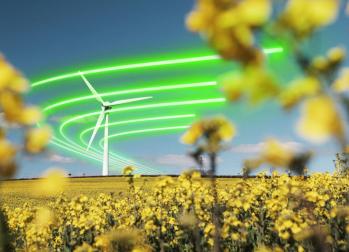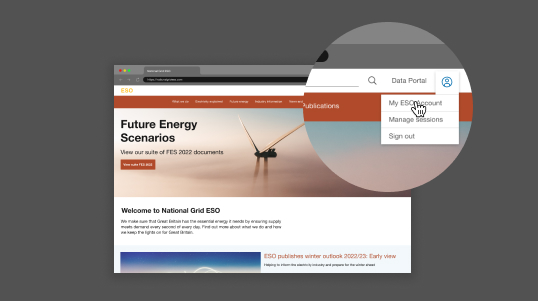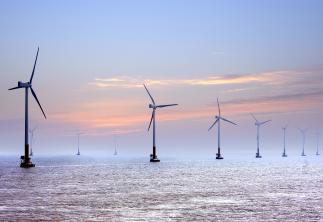The Network Option Assessment (NOA) provides our recommendation for which network reinforcement projects should receive investment - and when. While we provide economic recommendations for reinforcements that will enable the flow of electricity around the transmission system, to facilitate the evolving energy landscape, we are not responsible for making the final decision on what, where and when to invest.
The NOA 2021/22 Refresh replaces the previously published NOA 2021/22 and incorporates the recommended offshore network design set out in the Holistic Network Design (HND).

Download the NOA publication
Download NOA 2021/22 Refresh interactive report
The NOA Refresh and The Pathway to 2030 Holistic Network Design
The Pathway to 2030 Holistic Network Design helps to unlock the UK Government's ambition for 50 GW of offshore wind by 2030, by setting out a single, integrated approach that supports large scale delivery of electricity from offshore wind, to where it is needed across Great Britain.
The NOA 2021/22 Refresh forms part of the suite of documents that make up the Pathway to 2030 Holistic Network Design.
As we move towards an energy landscape that is dominated by renewable and zero carbon electricity, we need to take a more strategic and coordinated approach to transmitting large volumes of renewable generation to our demand centres across GB. Whilst our current network meets our needs for today, looking to the future, we need to evolve the transmission network to make sure it is capable of enabling delivery of the Government's 2030 offshore wind ambition and net zero target.
What NOA can and can't do
- Recommend the most economic reinforcements, whether infrastructure build or alternatives, for investment over the coming years, to meet bulk power transfer requirements as outlined by the ETYS.
- Recommend when investments should be made under the single LW21+ scenario to deliver an efficient, coordinated, and economic future transmission system.
- Recommend whether the TOs should start, continue, hold, or stop reinforcement projects to make sure they are completed at a time that will deliver the most benefit to consumers
- Inform the HND of the most economic reinforcements for the onshore system that complement the HND offshore network for 2030.
- Address network compliance with NETS SQSS. Additional onshore reinforcements may be identified for network compliance, which is an integral part of designing a secure, operable, transmission system capable of facilitating net zero.
- Recommend customer connections. The NOA only recommends the most economic reinforcement to resolve wider network issues.
- Insist that reinforcement options are pursued. We can only recommend options based on our analysis. The TOs or other relevant parties are ultimately responsible for what, where and when they invest.
- Comment on the details of any specific option, such as how it could be planned or delivered. The TOs or other relevant parties decide how they implement their options.
- Evaluate the specific designs of any option, such as the choice of equipment, route, or environmental impacts. These types of decisions can only be made by the TOs or other relevant parties when the options are at a more advanced stage.
- Assess network asset replacement projects which don’t increase network capability or individual customer connections.
- Procure products or services. The NOA may highlight a need to explore options further, either through the NOA Pathfinder projects or further engagement with the industry.
- Recommend options that offer no benefit to the boundaries we assess
What is the NOA 2021/22 Refresh?
The NOA 2021/22 Refresh is a key part of the network development process that will enable the delivery of the Government's offshore wind ambition. The NOA Refresh takes into consideration the recommended offshore network design that is set out in the HND, and identifies where on the onshore electricity transmission network there is a need for wider network reinforcement, to enable this additional electricity generation to flow from offshore wind farms to where it is needed, onshore.
The NOA process follows the previously published and approved NOA methodology. However, to align with the HND and ensure a consistent approach, some adjustments are necessary for this NOA 2021/22 Refresh. Where practicably possible, NOA 2021/22 Refresh follows the existing methodology, but differs in the following ways:
The NOA Refresh uses a single scenario that has been updated to include offshore connections for all generators in scope of the HND. We call this scenario LW21+.
To successfully deploy and connect the amount of offshore wind needed to achieve the Government's 2030 ambition, there are a number of different places on the network that need reinforcing. These reinforcements have been identified as HND essential options.
We have introduced a new term RISD for NOA Refresh projects that are essential to facilitate the 2030 targets but have an EISD (earliest in service date) of later than 2030 are given an RISD.
Investment recommendations
HND Essential Options for North of Scotland
| Code | Option description | EISD* | RISD** | Earliest optimal delivery date |
| BBNC | Beauly to Blackhillock 400 kV double circuit addition | 2030 | 2030 | |
| BLN4 | Beauly to Loch Buidhe 400 kV reinforcement | 2031 | 2030 | 2030 |
| BPNC | A new 400 kV double circuit between Blackhillock and Peterhead | 2031 | 2030 | 2030 |
| E4D3 | Eastern Scotland to England link: Peterhead to Drax offshore HVDC | 2029 | 2029 | |
| E4L5 | Eastern Scotland to England 3rd link: Peterhead to the south Humber offshore HVDC | 2031 | 2030 | 2030 |
| PSDC | Spittal to Peterhead HVDC reinforcement | 2030 | 2030 | |
| SLU4 | New network need between Loch Buidhe and Spittal | 2030 | 2030 | |
| TKUP | East Coast Onshore 400 kV Phase 2 reinforcement | 2032 | 2030 | 2030 |
*EISD is currently based on the current regulatory and consenting process and acceleration
** Accelerating these projects would require the Government intervention as suggested in the April 2022 BESS and equivalent activities in Scotland
Option found optimal in NOA 2021/22 Refresh
| Code | Option description | EISD* | Earliest optimal delivery date | NOA 2021/22 Refresh recommendation |
| BDUP | Uprate the Beauly to Denny 275 kV circuit to 400 kV | 2029 | 2030 | Hold |
| DLUP | Windyhill-Lambhill-Denny North 400 kV reinforcement | 2029 | 2029 | Proceed |
| DNEU | Denny North 400/275 kV second supergrid transformer | 2025 | 2026 | Hold |
| DWNO | Denny to Wishaw 400 kV reinforcement | 2028 | 2028 | Proceed |
| DWUP | Kincardine - Wishaw 400 kV reinforcement | 2026 | 2026 | Proceed |
| LWUP | Kincardine 400 kV reinforcement | 2027 | 2027 | Proceed |
| TFPC | Power flow control device along Tealing to Westfield | 2025 | 2027 | Hold |
*EISD is currently based on the current regulatory and consenting process and acceleration
HND Essential Options
| Code | Option description | EISD* | RISD | Earliest optimal delivery date |
| CDP3 | Additional alternative power control devices along Cellarhead to Drakelow | 2024 | 2027 | |
| CGNC | A new 400 kV double circuit between Creyke Beck and the south Humber | 2031 | 2030 | 2030 |
| CKPC | Power control device along Creyke Beck to Keadby to Killingholme | 2024 | 2025 | |
| CWPC | Power control device along Cottam to West Burton | 2024 | 2027 | |
| E2DC | Eastern subsea HVDC link from Torness to Hawthorn Pit | 2027 | 2027 | |
| EHRE | Elvanfoot to Harker reconductoring | 2028 | 2030 | |
| GWNC | A new 400 kV double circuit between the south Humber and south Lincolnshire | 2031 | 2030 | 2030 |
| KCEU | Creyke to Keadby to Killingholme circuits thermal uprating | 2022 | 2025 | |
| KCRE | Reconductor Cottam to Keadby 400 kV double circuit | 2025 | 2025 | |
| KWHW | Keadby to West Burton circuits thermal uprating | 2024 | 2024 | |
| KWP2 | Additional power control devices along the Keadby to West Burton number 1 circuit | 2025 | 2026 | |
| KWPC | Power control device along Keadby to West Burton | 2024 | 2024 | |
| LNRE | Reconductor Lackenby to Norton 400 kV single circuit | 2024 | 2030 | |
| NOR4 | Reconductor 13.75 km of Norton to Osbaldwick number 2 400 kV circuit | 2024 | 2030 | |
| NOR5 | Reconductor 13.75 km of Norton to Osbaldwick number 1 400 kV circuit to a higher rated conductor | 2024 | 2027 | |
| OPN2 | A new 400 kV double circuit between the existing Norton to Osbaldwick circuit and Poppleton and relevant 275 kV upgrades | 2027 | 2027 | |
| SHNS | Upgrade substation in the south Humber area | 2031 | 2030 | 2030 |
| TGDC | Eastern subsea HVDC Link from east Scotland to south Humber area | 2031 | 2030 | 2030 |
| VERE | Strathaven - Elvanfoot OHL conductor replacement | 2030 | 2030 | |
| VSRE | Strathaven - Smeaton OHL conductor replacement | 2027 | 2027 | |
| WRRE | Reconductor West Burton to Ratcliffe-on-Soar circuit | 2028 | 2030 |
*EISD is currently based on the current regulatory and consenting process and acceleration
** Accelerating these projects would require the Government intervention as suggested in the April 2022 BESS and equivalent activities in Scotland
Option found optimal in NOA 2021/22 Refresh
| Code | Option description | EISD* | Earliest optimal delivery date | NOA 2021/22 Refresh recommendation |
| BSHW | Blyth to Stella West circuits thermal uprating | 2024 | 2031 | Hold |
| CDHW | Cellarhead to Drakelow circuits thermal uprating | 2023 | 2023 | Proceed |
| CLNC | New North West England to Lancashire reinforcement | 2034 | 2036 | Hold |
| CMNC | South east Scotland to north west England AC onshore reinforcement | 2033 | 2033 | Proceed |
| CS05 | Commercial solution for Scotland and the north of England - stage 1 | 2024 | 2024 | Proceed |
| CS06 | Commercial solution for Scotland and the north of England - stage 2 | 2024 | 2024 | Proceed |
| CS11 | Commercial solution for the north of England - stage 1 | 2024 | 2024 | Proceed |
| CS12 | Commercial solution for the north of England - stage 2 | 2025 | 2025 | Proceed |
| HAE2 | Harker supergrid transformer 6 replacement | 2023 | 2023 | Proceed |
| HAEU | Harker supergrid transformer 5 and supergrid transformer 9A banking arrangement | 2022 | 2022 | Proceed |
| LCU2 | Eastern B5 400 kV reinforcement | 2031 | 2037 | Hold |
| LPD2 | Additional new HVDC link between North West England and North Wales | 2035 | 2037 | Hold |
| LPDC | New HVDC link between North West England and North Wales | 2035 | 2036 | Hold |
| MRP2 | Additional power control devices at both Harker and Penwortham | 2022 | 2022 | Proceed |
| NEMS | 225 MVAr MSCs within the north east region | 2025 | 2026 | Hold |
| NEP1 | Power control device along Blyth to Tynemouth and Blyth to South Shields | 2025 | 2025 | Proceed |
| NEPC | Power control device along Blyth to Tynemouth and Blyth to South Shields | 2024 | 2024 | Proceed |
| NOR6 | Reconductor the existing double circuit which runs from Norton to Osbaldwick | 2028 | 2037 | Hold |
| PWMS | Two 225MVAr MSCs at Penwortham | 2025 | 2027 | Hold |
| SNHW | Spennymoor to Norton circuit thermal uprating | 2024 | 2027 | Hold |
| SNRE | Reconductor the existing double circuit which runs from Spennymoor to Norton | 2027 | 2037 | Hold |
| SPRE | Reconductor the existing double circuit which runs from Spennymoor to Stella West | 2027 | 2037 | Hold |
| SSHW | Stella West to Spennymoor circuit thermal uprating | 2024 | 2027 | Hold |
| TLNO | East Coast Anglo-Scottish onshore reinforcement | 2037 | 2037 | Proceed |
| WCNC | West Coast onshore Anglo-Scottish new circuit | 2036 | 2036 | Proceed |
*EISD is currently based on the current regulatory and consenting process and acceleration
HND Essential Options
| Code | Option description | EISD* | RISD | Earliest optimal delivery date |
| AENC | A new 400 kV double circuit in north East Anglia | 2030 | 2030 | |
| ATNC | A new 400 kV double circuit in south East Anglia | 2030 | 2030 | |
| BMM2 | 225 MVAr MSCs at Burwell Main | 2022 | 2022 | |
| BPRE | Reconductor the newly formed second Bramford to Braintree to Rayleigh Main circuit | 2028 | 2028 | |
| BRRE | Reconductor remainder of Bramford to Braintree to Rayleigh route | 2023 | 2023 | |
| BTNO | A new 400 kV double circuit between Bramford and Twinstead | 2028 | 2028 | |
| CDP1 | Power control device along Cellarhead to Drakelow | 2024 | 2027 | |
| CDP2 | Power control device along Cellarhead to Drakelow | 2024 | 2027 | |
| DFRE | Reconductor Drax to Fenwick Tee 400 kV circuit | 2026 | 2030 | |
| DREU | Generator circuit breaker replacement to allow Thornton to run a two-way split | 2025 | 2025 | |
| EBRE | Reconductor Enderby to Patford Bridge to East Claydon 400 kV double circuit | 2026 | 2030 | |
| EDEU | 400 kV upgrade of Brinsworth to Chesterfield double circuit and Chesterfield to High Marnham double circuit. New High Marnham and Chesterfield 400 kV substations | 2027 | 2028 | |
| EDN2 | New Chesterfield to Ratcliffe-on-Soar 400 kV double circuit | 2032 | 2030 | 2030 |
| ESC1 | Second Elstree to St John’s Wood 400 kV circuit | 2026 | 2029 | |
| GCHW | Cottam to Market Harborough to Grendon circuit thermal uprating | 2025 | 2030 | |
| HWUP | Uprate Hackney, Tottenham and Waltham Cross 275 kV to 400 kV | 2027 | 2027 | |
| IFR1 | Feckenham to Ironbridge circuit reconductoring | 2025 | 2030 | |
| LRN4 | New network need from North Lincolnshire to Hertfordshire | 2033 | 2030 | 2030 |
| NBRE | Reconductor Bramford to Norwich double circuit | 2023 | 2023 | |
| SCD1 | New Offshore HVDC link between Suffolk and Kent option 1 | 2030 | 2030 | |
| SER1 | Elstree to Sundon reconductoring | 2024 | 2024 | |
| SER2 | Elstree to Sundon 2 circuit turn-in and reconductoring | 2026 | 2029 | |
| WSEU | Thermal upgrade for Sundon and Wymondley 400 kV substation | 2024 | 2025 | |
| WYTI | Wymondley turn-in | 2024 | 2028 |
*EISD is currently based on the current regulatory and consenting process and acceleration
** Accelerating these projects would require the Government intervention as suggested in the April 2022 BESS and equivalent activities in Scotland
Option found optimal in NOA 2021/22 Refresh
| Code | Option description | EISD* | Earliest optimal delivery date | NOA 2021/22 Refresh recommendation |
| BFHW | Bramley to Fleet circuits thermal uprating | 2024 | 2025 | Hold |
| BFPC | Power control device along Bramley to Fleet | 2025 | 2029 | Hold |
| BFRE | Bramley to Fleet reconductoring | 2025 | 2026 | Hold |
| BWRE | Reconductor Barking to West Ham double circuit | 2025 | 2028 | Hold |
| CS07 | Commercial solution for East Anglia - stage 1 | 2025 | 2025 | Proceed |
| CS08 | Commercial solution for East Anglia - stage 2 | 2025 | 2025 | Proceed |
| CTRE | Reconductor remainder of Coryton South to Tilbury circuit | 2022 | 2022 | Proceed |
| ERPC | Power control devices along the Enderby to Ratcliffe circuits | 2026 | 2033 | Hold |
| FHRE | Reconductor the existing 400 kV single circuit which runs from Feckenham to Hams Hall | 2027 | 2033 | Hold |
| GCRE | Reconductor the existing double circuit which runs from Cottam to Grendon | 2028 | 2037 | Hold |
| MBHW | Bramley to Melksham circuits thermal uprating | 2024 | 2026 | Hold |
| MBRE | Bramley to Melksham reconductoring | 2026 | 2027 | Hold |
| NBEU | Thermal upgrade for Bramford and Norwich 400 kV substations | 2025 | 2028 | Hold |
| NTP1 | Power control device north of Tilbury 400 kV | 2024 | 2024 | Proceed |
| PEM1 | 225 MVAr MSCs at Pelham | 2024 | 2024 | Proceed |
| PEM2 | 225 MVAr MSCs at Pelham | 2024 | 2024 | Proceed |
| RHM1 | 225 MVAr MSCs at Rye House | 2024 | 2024 | Proceed |
| RHM2 | 225 MVAr MSCs at Rye House | 2024 | 2024 | Proceed |
| RTRE | Reconductor remainder of Rayleigh to Tilbury circuit | 2022 | 2022 | Proceed |
| SEEU | Reactive compensation protective switching scheme | 2024 | 2024 | Proceed |
| TGP1 | Power control device along Tilbury to Grain | 2024 | 2024 | Proceed |
| TKP1 | Power control device along Tilbury to Kingsnorth | 2024 | 2026 | Hold |
| TKRE | Tilbury to Grain and Tilbury to Kingsnorth upgrade | 2028 | 2028 | Proceed |
| TWNC | Upgrade Wymondley, Waltham Cross and Tilbury 275 kV to 400 kV | 2033 | 2033 | Proceed |
| WAM1 | 225 MVAr MSCs at Walpole | 2025 | 2025 | Proceed |
| WAM2 | 225 MVAr MSCs at Walpole | 2025 | 2025 | Proceed |
| WCC1 | Cable replacement at Hinksey | 2027 | 2037 | Hold |
| WWNC | New South Lincolnshire to East Anglia double circuit | 2032 | 2033 | Hold |
*EISD is currently based on the current regulatory and consenting process and acceleration
HND Essential Options
| Code | Option description | EISD* | RISD** | Earliest optimal delivery date |
| PSNC | New network need between North Wales and South Wales | 2037 | 2030 | 2030 |
| PTC1 | Pentir to Trawsfynydd cable replacement | 2027 | 2028 | |
| PTNO | North Wales reinforcement | 2028 | 2029 |
*EISD is currently based on the current regulatory and consenting process and acceleration
** Accelerating these projects would require the Government intervention as suggested in the April 2022 BESS and equivalent activities in Scotland
Option found optimal in NOA 2021/22 Refresh
| Code | Option description | EISD* | Earliest optimal delivery date | NOA 2021/22 Refresh recommendation |
| CS20 | Commercial solution for north of Wales - stage 1 | 2026 | 2033 | Hold |
| CS21 | Commercial solution for north of Wales - stage 2 | 2026 | 2033 | Hold |
| HBUP | Uprate Bridgewater to 400 kV and reconductor the route to Hinkley | 2024 | 2027 | Hold |
*EISD is currently based on the current regulatory and consenting process and acceleration
Discover more about the NOA
The Beyond 2030 report builds on top of the Holistic Network Design and makes a set of network recommendations throughout the 2030s.
Subscribe to our monthly newsletter to stay up to date with all of the latest news in Network Development, including NOA, ETYS and NOA Pathfinder projects.
The options that are analysed in the NOA fall into two main groups, Asset-based options and ESO proposed options. This year we received a total of 171options which were placed into various categories.








